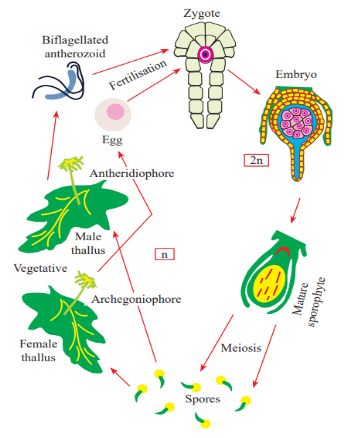

The life cycle of bryophytes is a crucial biological process that involves an alternation of generations between the gametophyte and sporophyte. Bryophytes, including mosses, liverworts, and hornworts, are non-vascular, autotrophic plants that predominantly thrive in damp environments. This unique life cycle allows bryophytes to reproduce in moist habitats and is a key topic for the NEET syllabus , providing insights into the evolutionary adaptations of plants.
Life Cycle of Bryophytes
The life cycle of bryophytes involves a series of stages where the plant alternates between a gametophyte and a sporophyte phase. Unlike most plants, the dominant phase in bryophytes is the gametophyte , which is the green, photosynthetic, and independent stage. In contrast, the sporophyte is smaller, non-photosynthetic, and depends on the gametophyte for nutrition.Male Sex Organ: Antheridium
The antheridium is the male sex organ of bryophytes. It produces biflagellated antherozoids (sperm cells). These sperm cells are motile and swim through a thin layer of water to reach the female sex organ for fertilization.Female Sex Organ: Archegonium
The archegonium is the female sex organ, and it has a distinct flask shape. It produces a single egg cell that will fuse with a sperm cell during fertilization to form the zygote. The egg is found in the enlarged region of the archegonium.Definition of Bryophytes
Bryophytes are autotrophic, avascular (lacking vascular tissue), archegoniate plants, meaning they reproduce through structures called archegonia (female reproductive organs). They display heteromorphic alternation of generations, where the two generations are morphologically different and alternately appear in the life cycle. In bryophytes, the gametophyte generation is the dominant, independent phase, responsible for photosynthesis and nutrient acquisition. In contrast, the sporophyte is a dependent phase that depends on the gametophyte for both support and nourishment throughout its life cycle. This relationship is key to understanding the unique life cycle of bryophytes.Life Cycle of Bryophytes
The life cycle of bryophytes is characterized by two main phases:
Gametophyte Phase (Haploid)
- The gametophyte is the dominant, independent phase in the life cycle of bryophytes.
- It develops from a haploid spore and consists of a leafy or thalloid structure.
- The gametophyte is responsible for sexual reproduction, producing gametes (sperm and egg cells) in specialized organs called antheridia (male) and archegonia (female).
- Water is required for the fertilization process, as the sperm must swim through the water to reach the egg.
- After fertilization, a diploid zygote is formed within the archegonium.
Sporophyte Phase (Diploid)
- The sporophyte is the diploid phase and grows from the fertilized zygote within the archegonium of the female gametophyte.
- Unlike the gametophyte, the sporophyte is dependent on the gametophyte for nutrients and water.
- The sporophyte is made up of a foot, a stalk (seta), and a capsule that generates spores.
- The sporophyte undergoes meiosis to produce haploid spores that are released into the environment.
- These spores will develop into new gametophytes, thus finishing the cycle.

Alternation of Generations in Bryophytes
Bryophytes display heteromorphic alternation of generations, meaning the gametophyte and sporophyte are structurally different. The life cycle alternates between the haploid gametophyte generation and the diploid sporophyte generation, with the gametophyte being the dominant phase. This alternation ensures genetic diversity and continuity in the plant population.
MCQs of Life Cycle of Bryophytes
Q1. The prominent phase in the life cycle of bryophytes is;
- gametophyte.
- sporophyte.
- seta.
- sporogonium.
Q2. In bryophyte embryo develops inside the;
- archegonium.
- antheridium.
- sporophyll.
- cone.
Q3. The main plant body of bryophytes is;
- diploid.
- haploid.
- sporophyte.
- Both (2) and (3)
Answers of MCQs of the Life Cycle of Bryophytes
Ans1 . Gametophyte, Ans2 . Archegonium, Ans3 . Haploid. Unlock your potential with Physics Wallah's NEET coaching ! Our expert educators provide comprehensive study materials, interactive classes, and personalized guidance to help you excel in your NEET exams .
| NEET Exam Important Links | |
|---|---|
| NEET Syllabus | NEET Biology Diagrams |
| NEET Biology MCQ | NEET Biology Chapter wise Weightage |
| NEET Biology Notes | NEET Previous Year Question papers |
Life Cycle of Bryophytes FAQs
Q. Why are bryophytes known as "amphibians of the plant kingdom"?
Q. What is the dominant phase in the life cycle of bryophytes?
Q. Why is the sporophyte dependent on the gametophyte in bryophytes?
Q. What is the function of the capsule in bryophytes?
Q. How does water availability affect bryophyte reproduction?












